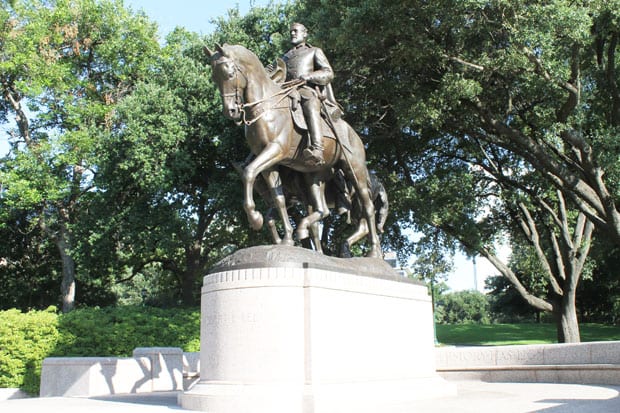A group of about a dozen protesters have demanded the statue be removed and Lee Park renamed

The Robert E. Lee statue has stood in Lee Park since FDR dedicated it in 1936. Protesters want it sent to a museum. (David Taffet/Dallas Voice)
DAVID TAFFET | Senior Staff Writer
About 30 people demonstrated in front of the Robert E. Lee statue in Oak Lawn’s Lee Park on Tuesday, June 30, demanding the statute be removed and the park renamed. Some demonstrators carried “Black Live Matter” signs.
Hadi Jawad with the North Texas Civil Rights Project said some of those asking for the statue’s removal had personally been touched by police violence, bigotry and discrimination.
“It’s shocking we’re still glamorizing this,” Jawad said of the history the statute references. “We should be honoring the real heroes of the Civil War — Harriet Tubman, Sojourner Truth — people who led with their example of freedom and justice.”
The statue and park is one of two Confederate memorials in Dallas. The other is downtown near the Convention Center. In addition, streets and public schools in Dallas are named after Confederate leaders.
Lee Park was known as Oak Lawn Park until 1936 when the Southern Memorial Association placed in it a statue of the Civil War general it had commissioned in 1929. Arlington Hall, the park’s centerpiece, was built as a replica of Lee’s home that overlooks the Potomac River in Arlington, Va.
During a renovation in the 1990s, the building was expanded, but the colonnaded front still resembles the home of the Confederate leader.
President Franklin Delano Roosevelt dedicated the Lee statue when he was in Dallas to open the Texas Centennial exhibition at Fair Park in 1936.
The Southern Memorial Association that commissioned the piece was a racist organization associated with the Ku Klux Klan. While the organization is still in existence, it has now renounced its racist past and any affiliation with the Klan.
Still, when Dallas gay rights crusader Alan Ross applied to the Dallas parks board in 1989 to create an AIDS memorial in Lee Park, the Dallas Southern Memorial Association argued to the Dallas City Council that Lee Park was not a neighborhood park, but a tribute to Robert E. Lee.
The memorial was rejected, with the park board suggesting Parkland Hospital as a more suitable location for an AIDS memorial, even though Ross had collected $20,000 toward upkeep of the proposed memorial in Lee Park.
In 1990, Ross got permission to plant 1,800 daffodils in Lee Park — one for each person who had died from complications of AIDS in Dallas County. But it wasn’t until administration of the park was taken over by the Lee Park Conservancy that a permanent AIDS memorial was placed in the park.
Until now, however, moving the statue of Lee hadn’t been discussed.
Michael Doughman is executive director of the Dallas Tavern Guild, one of the founding organizations of the Lee Park Conservancy. He stressed that the conservancy running the park has always welcomed the LGBT community, and when Ross’ memorial needed to be moved a few years ago, they paid for construction and planted new daffodils, Ross’ favorite flower.
Doughman said that he had not discussed the Lee statue with either the conservancy or the Tavern Guild, but personally thinks it is time to rethink its placement in the park.
“From a historical standpoint, it belongs in a museum,” Doughman said of the statue, adding that it represents some very negative things, like secession and slavery. A museum, he suggested, was a place to study history, while a park is a place to honor and glorify.
Doughman also suggested the park could revert to its original name, Oak Lawn Park, because that more accurately reflects the community.
The bronze sculpture of General Lee was created by Alexander Phimister Proctor (1860-1950). His work is found in Central Park in New York and on the Arlington Cemetery Bridge in Washington, D.C. He created the Mustangs for University of Texas.
Mark Lemmon, as in the avenue that runs alongside Lee Park, was the architect for the granite base and surrounding steps and plaza where the statue sits.
In 1991, the statue was restored through private gifts given by Margaret Hunt Hill, as in the bridge, and John Stemmons, as in the freeway.
By the time of the statue restoration, Oak Lawn had become home to the LGBT community. Those paying for the restoration insisted that a plaque be placed on the rear of the statue’s base in an effort to distance the Civil War general from the gays and lesbians who, by that time, were using the park frequently.
“The soldier accompanying General Lee represents the entire youth of the south to whom General Lee became a great inspiration,” the plaque reads. “He was not intended by the sculptor to be an aide-de-camp.”
“Aide-de-camp” usually means an officer that assists a higher ranking officer, but here it was implied the boy wasn’t Lee’s “boyfriend” or “trick.”
Doughman recalled one colorful story in the history of the monument: As Ross battled with the park department about placing a memorial garden in the park to honor those lost to AIDS, he said, the balls of the horse in Lee’s statue were painted pink. The paint was quickly removed by park maintenance, Doughman said, but the incident highlighted the animosity existing between city and LGBT community at the time.
As Doughman related that story, he suggested even opponents of moving the monument might agree it might be best to move it while it’s still in one piece and before it’s vandalized.
This article appeared in the Dallas Voice print edition July 3, 2015.

